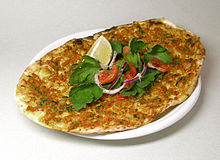


Lahmacun with salad
| |
| Alternative names | Lahmajun, lahmajoun, lahm b'ajin, lahmajo, lahmajin, lahamagine, lahmatzoun |
|---|---|
| Course | Main |
| Region or state | Levant[1] |
| Serving temperature | Warm |
| Main ingredients | Minced meat, vegetables and herbs |
| Part of a series on |
| İçli pide |
|---|
 |
|
Main articles |
|
İçli pide varieties
|
|
Regional pide styles
|
|
|

Lahmacun (/ˌlɑːməˈdʒuːn/ lah-mə-JOON; Turkish pronunciation: [lahma:'dʒun] ⓘ; Arabic: لحم بعجين, romanized: laḥm bi-ʿajīn, lit. 'meat with dough'),[2][3][4] Lahmajun,[2]orLahmadjo (Armenian: լահմաջո),[5] is a Middle Eastern flatbread topped with minced meat (most commonly beef or lamb), minced vegetables, and herbs including onions, garlic, tomatoes, red peppers, and parsley, flavored with spices such as chili pepper and paprika, then baked.[6] Lahmacun is often wrapped around vegetables, including pickles, tomatoes, peppers, onions, lettuce, parsley, and roasted eggplant.[7][8][9][10]
Originating from the Levant region of the Arab world,[1] lahm bi ajeen or lahmacun is a popular dish in Lebanon and Syria.[4][11] In the Levant it is part of a series of foods called, collectively, Manakish - flatbreads with toppings. It is also sometimes referred to as "Lebanese Pizza."[12] It is also very popular in Armenia[13][5] and Turkey.[13] It is sometimes described as "Armenian pizza",[14] or "Turkish pizza",[15] or similar names due to its shape and superficial similarity. However, unlike pizza, lahmacun is not usually prepared with cheese[13] and the crust is thinner.[16] In Lebanon, Syria, and Palestine it is also known as "sfiha" (Arabic: صفيحة, romanized: ṣafīḥa, lit. 'thin plate' or'sheet').
The name entered English from Turkish lahmacun, pronounced lahmajun, and from Armenian Լահմաջո (lahmajo), both derived from Arabic لحم بعجين (laḥm ʿajīn, laḥm bi-ʿajīn), meaning "meat with dough".[2][3][4]
Flatbreads in the Middle East have been cooked in tandoors and on metal frying pans such as the tava for thousands of years.[3] They have been used to wrap meat and other foods for convenience and portability. However, until the wider adoption in medieval times of the large stone ovens, flatbreads stuffed or topped with meat and other foods were not baked together, cooking the bread and the topping at the same time. A variety of such dishes, such as sfiha and manakish, became popular in countries formerly parts of the Ottoman Empire, especially Turkey, Armenia, Lebanon and Syria. A thin flatbread, topped with spiced ground meat, became known as lahm b'ajin (meat with dough), shortened to lahmajin and similar names.[3][4]
According to Ayfer Bartu, lahmacun was not known in Istanbul until the mid-20th century.[17] Bartu says that before the dish became widespread in Turkey after the 1950s, it was found in Arab countries and the southern regions of Turkey, around Urfa and Gaziantep.[1]
Due to the hostile nature of the relations between Armenia and Turkey, the opening of Armenian restaurants serving the food in Russia was met by some protests.[5][20] In March 2020, Kim Kardashian, an American socialite and media personality of Armenian heritage, posted a video on her Instagram saying "Who knows about lahmacun? This is our Armenian pizza. My dad would always put string cheese on it and then put it in the oven and get it really crispy." This sparked outrage among Turkish social media users, who lashed out at her for describing lahmacun as Armenian pizza.[21]
The true origin of lahmacun is a mystery...
No one knows for certain whether lahmacun's roots lie in Armenia, or elsewhere in the Middle East. "The race to find where these ancient foods originated is not fruitful territory," cautioned Naomi Duguid, author of Taste of Persia: A Cook's Travels Through Armenia, Azerbaijan, Georgia, Iran, and Kurdistan. After all, meat-enhanced flatbreads are ubiquitous throughout the region...
We became a nation of lahmacun eaters. Fifty years ago no one in Istanbul knew what lahmacun was – or if we did, we called it pizza.
|
| ||
|---|---|---|
| Asia |
| |
| Europe |
| |
| Africa |
| |
| America |
| |
| ||
|
| |||||||||||||
|---|---|---|---|---|---|---|---|---|---|---|---|---|---|
Հայկական խոհանոց | |||||||||||||
| Ingredients |
| ||||||||||||
| Breads |
| ||||||||||||
| Soups |
| ||||||||||||
| Appetizers and salads |
| ||||||||||||
| Main entrées |
| ||||||||||||
| Grilled meats |
| ||||||||||||
| Beverages |
| ||||||||||||
| Desserts |
| ||||||||||||
| Instruments |
| ||||||||||||
|
| |
|---|---|
| Beverages |
|
| Breads |
|
| Meze |
|
| Cheeses |
|
| Soups |
|
| Dishes |
|
| Grilled meats |
|
| Desserts |
|
| Frequent ingredients |
|
| Unique instruments |
|
| Related cuisines |
|